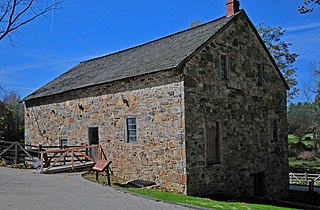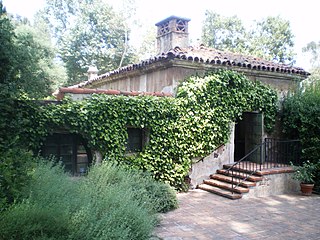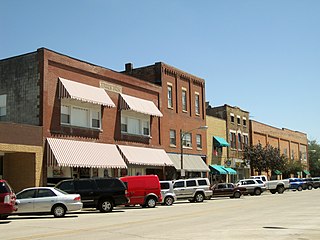History
Henry A. Rathje is credited with building the windmill, but it was his father, Frederick Rathje, with Christoph Elling, who agreed to build the mill. The warranty deed from July 3, 1871 confirms this. An account of the Rathje family was contained in the 1900 Genealogical and Biographical Record of Will County. According to it, Rathje (Henry) married Wilhelmina Luhmann in 1874, Luhmann was an immigrant from Hanover, Germany. After marrying, Rathje entered the milling business during which time he acquired the windmill at Peotone and operated it for twelve years. Henry Rathje is listed as the proprietor on a mill invoice. [1]
The structure was designed by Dutch millwrights. The design, which included the mill's 60 foot tower, makes it the only "skyscraper" in Peotone. The mill's integrity has, for the most part, been maintained throughout its existence and it is a familiar visual landmark in Peotone and Will County. [3]

Bale Grist Mill State Historic Park is a California state park located in Napa County between St. Helena and Calistoga. The park is the site of a water-powered grist mill that was built in 1846 is one of only two water-driven mills remaining west of the Mississippi River.

Stembridge Tower Mill in High Ham, Somerset, England, is the last remaining thatched windmill in England. The mill is a grade II* listed building.

The Graue Mill is a water-powered grist mill that was originally erected in 1852. Now a museum, it is one of two operating water-powered gristmills in Illinois. It is located on Salt Creek in Oak Brook, Illinois, owned by the Forest Preserve District of DuPage County and operated by a nonprofit preservationist group.

Kymulga Mill & Covered Bridge are two locally owned historic landmarks located at Kymulga Park in Talladega County, Alabama, United States. The park is on Grist Mill Road off State Route 76 about 4 miles northeast of the city of Childersburg.

McConnell's Windmill, also known as Morristown Windmill and Stone Windmill, is a stone windmill in Morristown, New York. It was built in 1825, and is a coursed rubble stone structure measuring 40 feet tall and 77 feet in circumference. It was used as a grist mill. The building has been used as a jail and as an Air Warning System Observation Post during World War II. It is the only windmill on the American side of the St. Lawrence Valley.

The Mill at Anselma is an archetypal small, 18th century custom grain mill in Anselma, outside Chester Springs, Pennsylvania. It is probably the only surviving one in the United States with an intact colonial-era power transmission system. A custom grain mill typically ground cornmeal and flour only for local farmers, not for commercial distribution. It was designated a National Historic Landmark in 2005.

The Fabyan Windmill is an authentic, working Dutch windmill dating from the 1850s located in Geneva, Kane County, Illinois, just north of Batavia, Illinois, off Illinois Route 25. The five-story wooden smock mill with a stage, which stands 68 feet (21 m) tall, sits upon the onetime estate of Colonel George Fabyan, but is now part of the Kane County Forest Preserve District.

Boyd's Windmill, also known as Boyd's Wind Grist Mill, is a historic smock mill at Paradise Valley Park on Prospect Avenue in Middletown, Rhode Island. John Peterson built the windmill at the corner of Mill Lane and West Main Rd. in Portsmouth, Rhode Island in 1810, and William Boyd purchased it in 1815. It originally had four common sails, but four more were added by the family. The mill is a timber-frame structure, octagonal in shape, and about 30 feet (9.1 m) tall, with a rotating cap powered by eight vanes with canvas sheets. The grindstones in the middle of the mill are Fall River granite; the upper one, which is connected to the power mechanisms, rotates six times for each turn of the mill's main shaft. In 1916 Benjamin Boyd removed the original vanes and powered the mill using a gasoline engine. It is one of only two historic windmills to survive on Aquidneck Island.

Victoria Grist Windmill is an historic gristmill in Memorial Square in Victoria, Texas, United States. The windmill was added to the National Register of Historic Places on April 30, 1976, and became an American Society of Mechanical Engineers Landmark in May 1991.

Gladden Windmill is an historic windmill formerly located on Pigeon Valley Road in Napoli, Cattaraugus County, New York. The windmill was built in 1890 and is a well-preserved example of a vertical wind turbine built during the 19th century. Although no longer operational, the turbine is a rare example of wind power technology in the United States.

Shelter Island Windmill is an historic windmill north of Manwaring Road in Shelter Island, Suffolk County, New York. It was built in 1810. Master Millwright Nathaniel Dominy V (1770–1852) was the architect and builder of the windmill. The windmill has been on Shelter Island since 1840 and at its current location since 1926 on the Sylvester Manor farm.

El Molino Viejo, also known as The Old Mill, is a former grist mill in the San Rafael Hills of present-day San Marino, California, United States, and was built in 1816 by Father José María de Zalvidea from the Mission San Gabriel Arcángel. It is the oldest commercial building in Southern California, and was one of the first ten sites in Los Angeles County to be listed on the National Register of Historic Places, receiving the recognition in 1971. The Old Mill has also been designated as a California Historical Landmark.

The Wayside Inn Historic District is a historic district on Old Boston Post Road in Sudbury, Massachusetts. The district contains the Wayside Inn, a historic landmark that is one of the oldest inns in the country, operating as Howe's Tavern in 1716. The district features Greek Revival and American colonial architecture. The area was added to the National Register of Historic Places in 1973.

The Landmark Inn State Historic Site is a historic inn in Castroville, Texas, United States. It serves the general public as both a state historic site and a bed & breakfast with eight overnight rooms.

Aurora Steam Grist Mill was a historic grist mill located in Aurora, Cayuga County, New York. It was a monolithic, 3+1⁄2-story rectangular stone structure built on the shore of Lake Cayuga. It was one of the first mills built west of the Hudson River to be powered by steam. In 1974, the building's roof collapsed due to neglect and plans were to restore it for use as a community center. It was largely intact until 1992, when Wells College began to demolish it in order to build a dock behind the Aurora Inn.

Water Mill is a historic watermill located at Water Mill in Suffolk County, New York, USA. It is a 2-story, heavy wood-frame structure with a wood-shingle exterior and composed of two building sections. There is a 2-story, square-shaped main section and 1-story, one-bay wing. Attached to the rear is a 2+1⁄2-story tower and 1-story glassed-in porch. The mill structure dates to the mid-17th century. It operated as a mill until the early 20th century. It is now a local museum.

The Downtown Peotone Historic District is a set of forty-two buildings in Peotone, Illinois. Of these, thirty-seven contribute to the historical integrity of the area.

Easton Roller Mill is a historic sawmill and grist mill located near Morgantown, Monongalia County, West Virginia. Construction began in 1864 and was completed in 1867. During the first 10 or so years, the mill changed hands from the original builder, Henry Koontz of Frostburg MD, about four times before mill-modernizer Isaac Morris bought the mill in 1894. Originally it was a 3 1/2-story rectangular, timber frame building with a shed addition; however, the shed was removed In recent years. Most mills of this era were exclusively using Burr stones for milling and grinding, however in 1894, the owner, Isaac Morris, installed roller mills for the production of high-grade white flour coming into popular demand. At that time, the Burr stone mill was relegated to grinding cornmeal, and so began a second business of cornmeal and animal feed products also sold at the Easton mill. It is probable Mr. Morris also installed the current steam engine, an 1875 Lane & Bodley 40 HP single expansion engine. The engine once ran on coal-generated steam; however, for insurance reasons, it now runs on compressed air for demonstration purposes. The mill ran under Mr. Morris' ownership until 1910. William C. Ley bought the mill in 1910 and ran it 24 hours a day until 1930. We are told that Mr. Ley was of German descent, was tall, spoke with a heavy accent, and often wore a thick black mustache under his wide brimmed hat. He was known for running a very expertly tuned operation, and keeping his equipment in perfect working order. We believe Mr. Ley potentially ran the mill seasonally through the 1930s, until his death in 1941. Between 1939 and Ley's death in 1941, Ley's daughter Estella Ley-Pickenpaugh and her husband Fred Pickenpaugh attempted to restore the mill to full working order, only to discover local wheat and grains unavailable, as most milling had moved to large-scale mills in the Midwest. During this time they may have been assisted by Mr. Ley's milling partner Frank A. Walls of Easton. It is unclear whether Walls held ownership interest in the mill at any time; however, his name appears on the cornmeal bags only. The mill was willed by Estella Ley-Pickenpaugh to the Monongalia Historical Society in 1978. In the fall-winter of 2012–2013, restoration work began at the mill. The mill is expected to be operating and touring visitors by spring 2013.

Thorp Mill is a historic building located in Thorp, Washington, United States.

The Gooseville Mill/Grist Mill is a historic mill on the North Branch Milwaukee River in Gooseville, Wisconsin. The mill was built in 1879 to replace an 1855 mill that had burned down. The mill is a small custom mill with board and batten siding and is typical of the custom mills common in Sheboygan County in the 1800s. A Lefel turbine powered the mill, replacing the paddle wheel used in the 1855 mill. A burr mill was used to grind the grain processed at the mill. As of 1984, the mill was still operational and occasionally used as a sawmill.





















